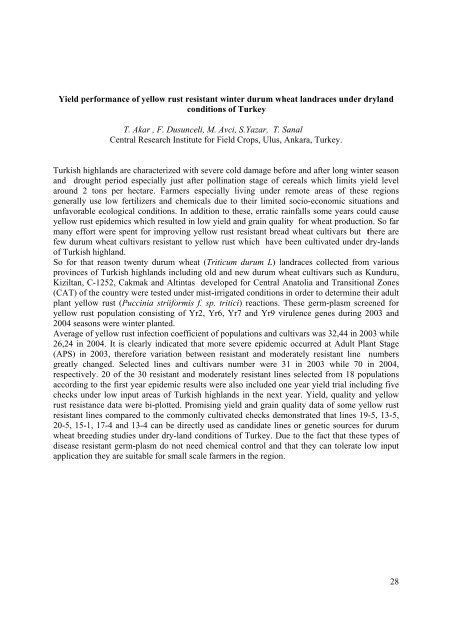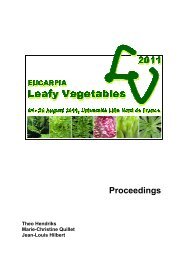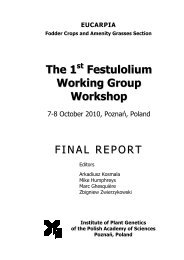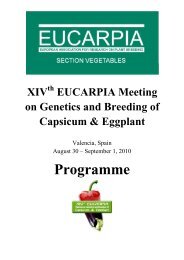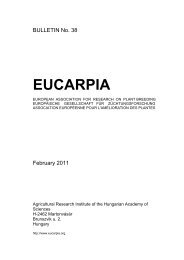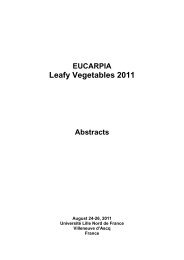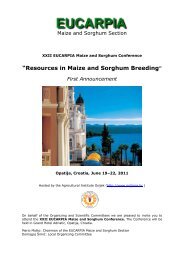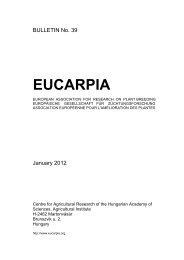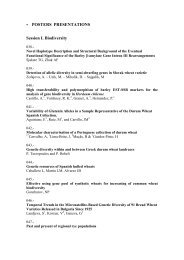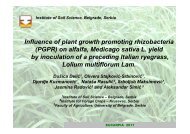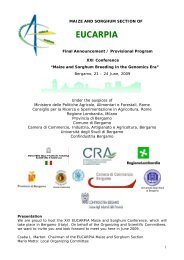Plant breeding for organic and sustainable, low-input agriculture
Plant breeding for organic and sustainable, low-input agriculture
Plant breeding for organic and sustainable, low-input agriculture
You also want an ePaper? Increase the reach of your titles
YUMPU automatically turns print PDFs into web optimized ePapers that Google loves.
Yield per<strong>for</strong>mance of yel<strong>low</strong> rust resistant winter durum wheat l<strong>and</strong>races under dryl<strong>and</strong><br />
conditions of Turkey<br />
T. Akar , F. Dusunceli, M. Avci, S.Yazar, T. Sanal<br />
Central Research Institute <strong>for</strong> Field Crops, Ulus, Ankara, Turkey.<br />
Turkish highl<strong>and</strong>s are characterized with severe cold damage be<strong>for</strong>e <strong>and</strong> after long winter season<br />
<strong>and</strong> drought period especially just after pollination stage of cereals which limits yield level<br />
around 2 tons per hectare. Farmers especially living under remote areas of these regions<br />
generally use <strong>low</strong> fertilizers <strong>and</strong> chemicals due to their limited socio-economic situations <strong>and</strong><br />
unfavorable ecological conditions. In addition to these, erratic rainfalls some years could cause<br />
yel<strong>low</strong> rust epidemics which resulted in <strong>low</strong> yield <strong>and</strong> grain quality <strong>for</strong> wheat production. So far<br />
many ef<strong>for</strong>t were spent <strong>for</strong> improving yel<strong>low</strong> rust resistant bread wheat cultivars but there are<br />
few durum wheat cultivars resistant to yel<strong>low</strong> rust which have been cultivated under dry-l<strong>and</strong>s<br />
of Turkish highl<strong>and</strong>.<br />
So <strong>for</strong> that reason twenty durum wheat (Triticum durum L) l<strong>and</strong>races collected from various<br />
provinces of Turkish highl<strong>and</strong>s including old <strong>and</strong> new durum wheat cultivars such as Kunduru,<br />
Kiziltan, C-1252, Cakmak <strong>and</strong> Altintas developed <strong>for</strong> Central Anatolia <strong>and</strong> Transitional Zones<br />
(CAT) of the country were tested under mist-irrigated conditions in order to determine their adult<br />
plant yel<strong>low</strong> rust (Puccinia strii<strong>for</strong>mis f. sp. tritici) reactions. These germ-plasm screened <strong>for</strong><br />
yel<strong>low</strong> rust population consisting of Yr2, Yr6, Yr7 <strong>and</strong> Yr9 virulence genes during 2003 <strong>and</strong><br />
2004 seasons were winter planted.<br />
Average of yel<strong>low</strong> rust infection coefficient of populations <strong>and</strong> cultivars was 32,44 in 2003 while<br />
26,24 in 2004. It is clearly indicated that more severe epidemic occurred at Adult <strong>Plant</strong> Stage<br />
(APS) in 2003, there<strong>for</strong>e variation between resistant <strong>and</strong> moderately resistant line numbers<br />
greatly changed. Selected lines <strong>and</strong> cultivars number were 31 in 2003 while 70 in 2004,<br />
respectively. 20 of the 30 resistant <strong>and</strong> moderately resistant lines selected from 18 populations<br />
according to the first year epidemic results were also included one year yield trial including five<br />
checks under <strong>low</strong> <strong>input</strong> areas of Turkish highl<strong>and</strong>s in the next year. Yield, quality <strong>and</strong> yel<strong>low</strong><br />
rust resistance data were bi-plotted. Promising yield <strong>and</strong> grain quality data of some yel<strong>low</strong> rust<br />
resistant lines compared to the commonly cultivated checks demonstrated that lines 19-5, 13-5,<br />
20-5, 15-1, 17-4 <strong>and</strong> 13-4 can be directly used as c<strong>and</strong>idate lines or genetic sources <strong>for</strong> durum<br />
wheat <strong>breeding</strong> studies under dry-l<strong>and</strong> conditions of Turkey. Due to the fact that these types of<br />
disease resistant germ-plasm do not need chemical control <strong>and</strong> that they can tolerate <strong>low</strong> <strong>input</strong><br />
application they are suitable <strong>for</strong> small scale farmers in the region.<br />
28


